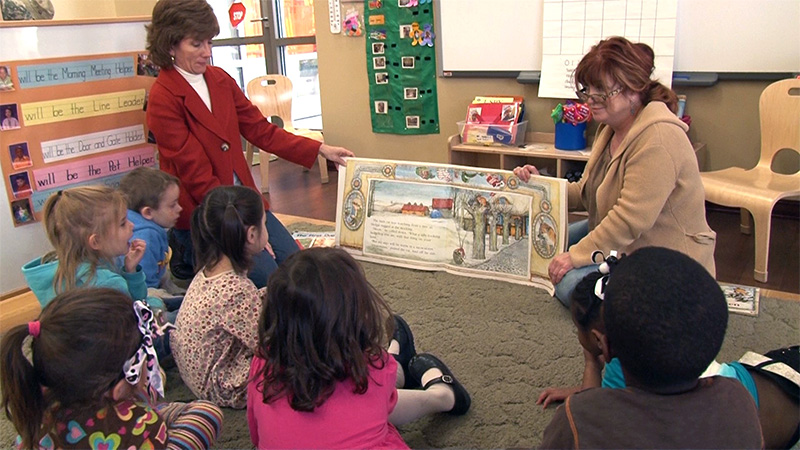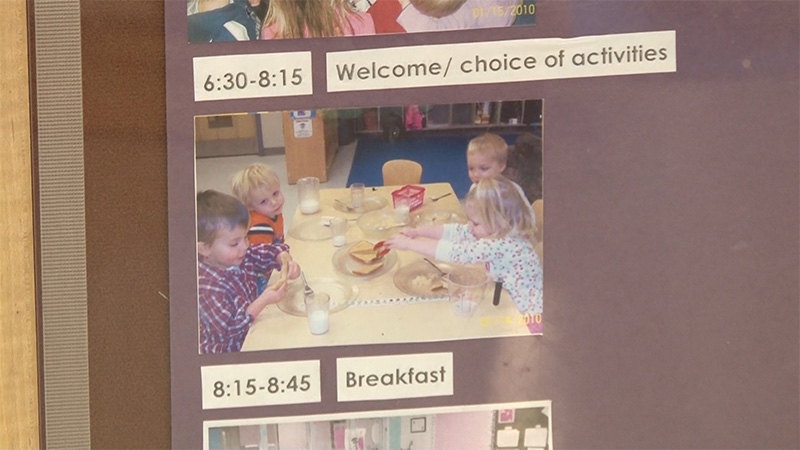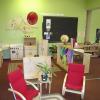- Teach staff members the components of an effective schedule.
- Model strategies for providing structured, yet flexible, schedules during interactions with adults.
- Observe and provide feedback on schedules and routines.
Learn
Teach
Creating an effective schedule is like putting together a favorite recipe. There are certain ingredients, or elements, that go into an effective schedule. The order and style of those elements will be unique to each staff member. As with some recipes, there is room for flexibility. Ingredients can be changed or adapted based on individual needs. The key to an effective schedule is structure and flexibility (Chung, Gannett, La Perla, 2001).
Across all age groups, a substantial portion of the programming day (i.e., at least one-third of the time the facility is open; Cryer, Harms, & Riley, 2003) should be dedicated to free-choice time. Especially in school-age programs, it is important to provide adequate time for children to engage in free-choice, unstructured activities. Most of their school day is highly structured, so this can be an important time to unwind and choose enjoyable activities on their own or with friends.
In most programs, some form of adult-guided large-group time occurs. In child development programs, this can be a chance to read stories to the group, discuss the daily schedule, and build classroom community. Although important events can take place at large group, it should be kept short. Young children learn best if group times are 15 to 20 minutes or less (Hemmeter, Ostrosky, Artman, & Kinder, 2008). For infants and toddlers, mandatory adult-directed activities are not developmentally appropriate. However, staff members can still offer “a group time” as a way to strengthen their classroom community, asking the children to come together to share songs or ideas (e.g., copying the motions of infants and toddlers; Lang et al., 2010). Infants and toddlers should be able to be active participants during group time, which should be short, perhaps five to 10 minutes. It is appropriate to offer infants and toddlers the choice to engage in this time and to offer stories, songs, or group activities with an adult and small group of peers at different points throughout the day. In school-age programs, adult-directed activities may be optional and may take a variety of forms: an opportunity to learn how to build model airplanes, a science experiment, or a structured outing. School-age programs may also offer a variety of optional group activities, like acting out a play, doing community service work, or playing sports.

Model
You are an instructional leader in your program, giving you the ability to model effective scheduling during staff meetings. Think about how staff meetings are organized and managed; you might work with your program’s manager to make sure staff meetings reflect your program’s commitment to structured, yet flexible, schedules. Make sure staff members receive an agenda before the meetings and that meetings always begin and end on time. Make sure mechanisms are in place for staff members to share their needs and opinions related to staff meetings (e.g., have staff members write ideas or questions on sticky notes to be read at the end of the meeting or use an anonymous feedback box). Use the concepts from this lesson when or if you provide group professional development events: Provide a mix of activities, let participants know what the schedule will be (and when restroom breaks and meals are), and be responsive to the feedback participants give you verbally and through body language. If adults look bored, it’s time to make a change.
Provide new staff members with sample schedules they can use as models for creating their own learning experiences for children. Make arrangements for them to visit other classrooms or programs for ideas. Make sure staff members know that they need to communicate their schedules with children and with adults. That is, they will always need to create two schedules: a simple one appropriate for the children in their care and a more detailed schedule for other staff members or families.

Observe
It is important to help staff members think about ways to use their time efficiently to maximize learning. Let’s watch a cooking activity with toddlers. How would you help the staff member brainstorm ways to refine this activity?
Case Study: Schedules and Routines
Case Example Step 1: Make a Plan
Upon reflection, the trainer or coach and teacher identified several changes that could make this learning experience more meaningful for the children. They developed a plan.
Goal: To reduce wait time while children transition from one activity to another by providing engaging experiences during all transitions.
Steps to reach the goal:
- Identify all the necessary transitions on our activity plans each day. Person responsible: Classroom lead and trainer or coach. Timeline: Planning time this week.
- Brainstorm a list of age-appropriate ways to engage children in the transitions (songs, dances, etc.). Person responsible: Classroom team and trainer or coach. Timeline: Planning time next week.
- Write all the materials necessary for each structured activity on the activity plan and make sure all materials are prepared before children arrive at the activity. Person responsible: staff member leading each activity. Timeline: During lesson planning weekly and immediately before each structured activity.
Case Example Step 2: Provide Feedback
The trainer or coach noticed several things during the observation. It’s important to notice and provide feedback on the teachers’ strengths. In this case:
The trainer or coach might also be prepared to ask the teachers several questions to help refine their practice. For example:
Case Example Step 3: Provide Resources
The trainer or coach might provide the classroom team with the materials identified in the action plan and feedback. For example, it could be helpful to create a visual that lets children know when it’s their turn at the table. The trainer or coach might also be available during planning time to provide curriculum resources and support with activity planning.
Additional Examples of Learning Environments
For infants and toddlers, it's important to offer short, child-initiated learning experiences. Let's watch a video on how effective schedules and routines promote cognitive development for very young children.
Infants & Toddlers: Promoting Cognitive Development
Use the menu at the left or the pager below to cycle through scenarios
See | You Saw:
|
|---|---|
Say | What you might say:
|
Do | What you might do:
|
See | You Saw:
|
|---|---|
Say | What you might say:
|
Do | What you might do:
|
See | You Saw:
|
|---|---|
Say | What you might say:
|
Do | What you might do:
|
A Range of Preschool Schedules and Routines
Use the menu at the left or the pager below to cycle through scenarios
See | You Saw:
|
|---|---|
Say | What you might say:
|
Do | What you might do:
|
See | You Saw:
|
|---|---|
Say | What you might say:
|
Do | What you might do:
|
See | You Saw:
|
|---|---|
Say | What you might say:
|
Do | What you might do:
|
A Range of School-Age Schedules and Routines
Use the menu at the left or the pager below to cycle through scenarios
See | You Saw:
|
|---|---|
Say | What you might say:
|
Do | What you might do:
|
See | You Saw:
|
|---|---|
Say | What you might say:
|
Do | What you might do:
|
Explore
In your work as a trainer or coach, you may come across staff who struggle with effective scheduling. Read the scenarios in the Scheduling Scenarios activity, and decide how you would respond. Then compare your answers to the suggested responses.
Apply
Use the Jigsaw activity as a resource to use with staff members who are struggling with their schedules. Follow the directions on the activity to help staff members identify issues and brainstorm solutions. Use the Schedules and Routines Best Practices Checklist as a focused observation tool to support staff that have completed the Learning Environments course but may need additional support or follow up on appropriate schedules and routines. This checklist provides an easy way to follow up on goals set around this topic and provides specific feedback to staff members about what you observed.
Glossary
Demonstrate
Chung, A., Gannett, E., & La Perla, A. A. (2001). After-School Programs: From vision to reality. Retrieved from http://www.thirteen.org/edonline/concept2class/afterschool/index.html
Cryer, D., Harms, T., & Riley, C. (2003). All About the ECERS-R: A detailed guide in words and pictures to be used with the ECERS-R. Lewisville, NC: Kaplan Early Learning Co.
Dodge, D. T., Colker, L. J., & Heroman, C. (2002). The Creative Curriculum for Preschool (4th ed.). Washington, DC: Teaching Strategies, Inc.
Feldman, J. (1995). Transition Time: Let’s do something different. Lewisville, NC: Gryphon House.
Feldman, J. (2000). Transition Tips and Tricks for Teachers. Lewisville, NC: Gryphon House.
Hemmeter, M. L., Ostrosky, M., Artman, K., & Kinder, K. (2008). Moving right along: Planning transitions to prevent challenging behavior. Young Children, 63, 18-25.
Lang, S. N., Aledia, T., Casey, K., & Kirkbride, K. (2010, April). Infant/Toddler Group Time: A time for creating & sustaining classroom culture. Presentation at Ohio Early Care & Education Conference, Columbus, OH.
Larson, N., Henthorne, M., & Plum, B. (2002). Transition Magician. St. Paul, MN: Redleaf Press.
Lentini, R., Vaughn, B. J., & Fox, L. (2004). Routine-Based Support Guide for Young Children With Challenging Behavior. Tampa, FL: University of South Florida, Early Intervention Positive Behavior Support. Retrieved from: https://www.ecmhc.org/TTYC/documents/Folder1TipsForms/File%20G%20Routine%20Based%20Support%20Guide/Routine%20Based%20Support%20Guide%20Rev1209.pdf
Wellesley Centers for Women at Wellesley College. (2015). National Institute on Out-of-School Time. Retrieved from http://www.niost.org/


